“The eye of the airplane is pitiless. This time we have the actual record of reality. What an appalling thing. Do human beings live here? Do they consent to do so? Will they not revolt against it?”
—Le Corbusier, Aircraft, 19351
In 1942, shortly after the bombing of Pearl Harbor, the encroachment of Japanese submarines on the American coast caused The Boeing Company to fear a similar raid on its own facilities. Boeing Plant 2, located outside of Seattle, Washington, was a primary target because of the plant’s proximity to the Pacific coast and its critical role in manufacturing military aircrafts. But a twenty-six-acre facility is not readily relocated, particularly during wartime, when its productivity is most desperately required. To avoid an attack, the base needed a disguise.
With this is mind, Boeing turned to John S. Detlie, an architect and Hollywood set designer, who proposed an idea to conceal Boeing Plant 2 within its suburban context by camouflaging the entire site with a fake townscape made of plywood and chicken wire. Nylon trees, plywood houses and cars, steel-wire streets—all suspended on twenty-six acres of layered mesh, contoured to the varying heights of the complex’s buildings below.2 Detlie quite literally draped the local urban fabric over the Boeing plant. What would appear from above as a rolling hill in the landscape was, in fact, an aircraft hangar in disguise.
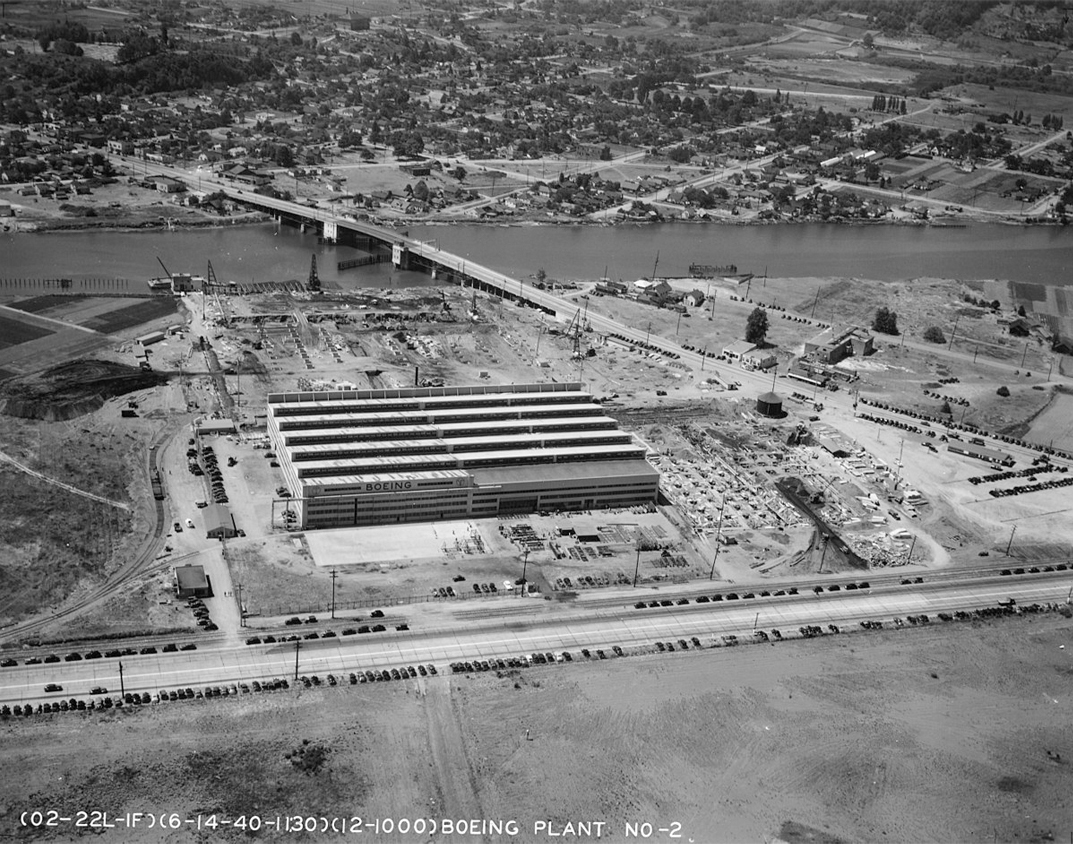
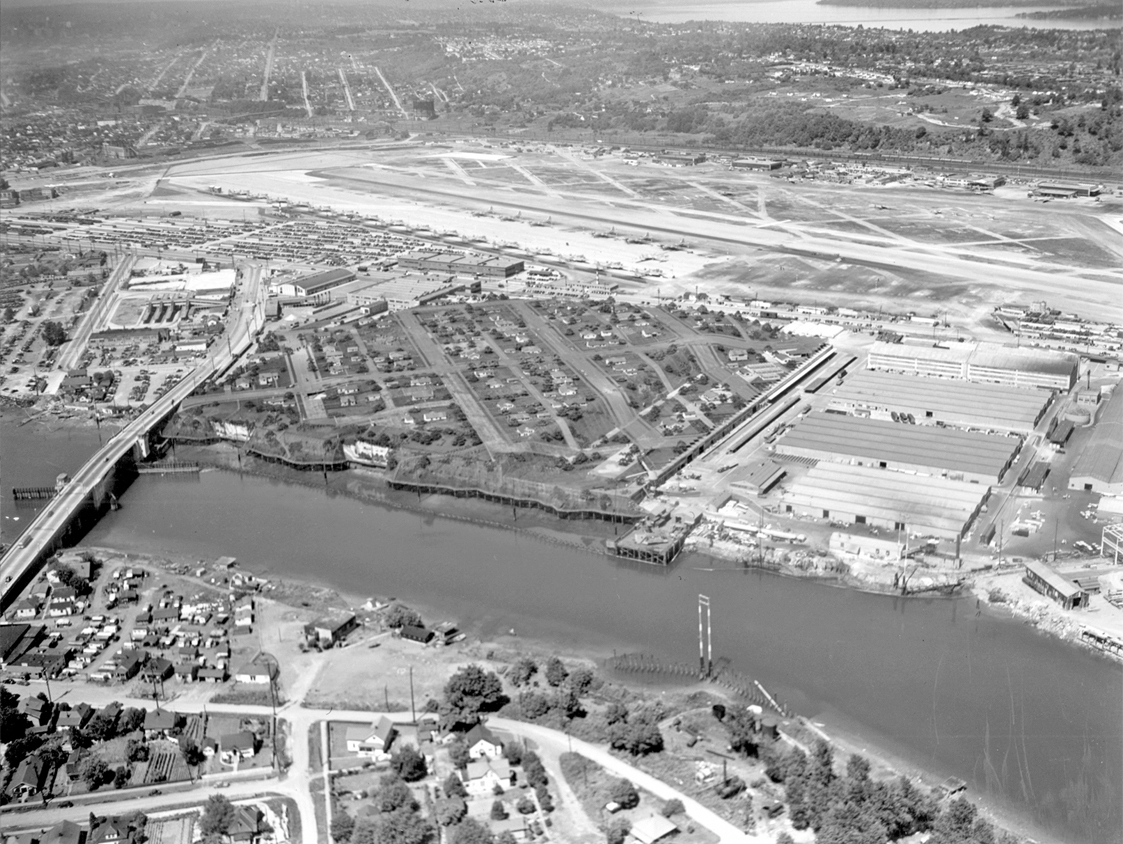
With the need to deceive both photographic records and real-time observations by Japanese pilots, Boeing embellished the camouflage with its own employees, who animated the fake townscape by simulating the daily routines of a typical 1940s suburban neighborhood.3 Photographs of people occupying Detlie’s design reveal the dissonance between the aerial and the ground-level view of the camouflage with comedic effect: From above, a man appears to perform maintenance on a vehicle, though in reality he stands next to a car-shaped plywood box that barely reaches the height of his knees; a woman, who would seem to any low-flying aircraft to be enjoying a shaded spot under a cluster of trees, in actuality sits beneath a canopy of perforated nylon netting supported on trunks of two-by-four studs; a pair of would-be neighbors appear to take a leisurely stroll down their ordinary Seattle street, though from ground level they’re clearly a full head taller than the nearby “houses” whose windows are merely black squares painted on particle-board walls. The people stood taller than homes built at half scale because the difference in height between a normal-size house and its counterfeit is indistinguishable from a bird’s-eye view. Created by a set designer and occupied by performers, the townscape disguise staged a theatrical play for a foreign audience watching from thousands of feet overhead. And for the next several years, a cog in the war machine would masquerade as an unassuming middle-class American neighborhood until the camouflage was finally removed in 1946.4
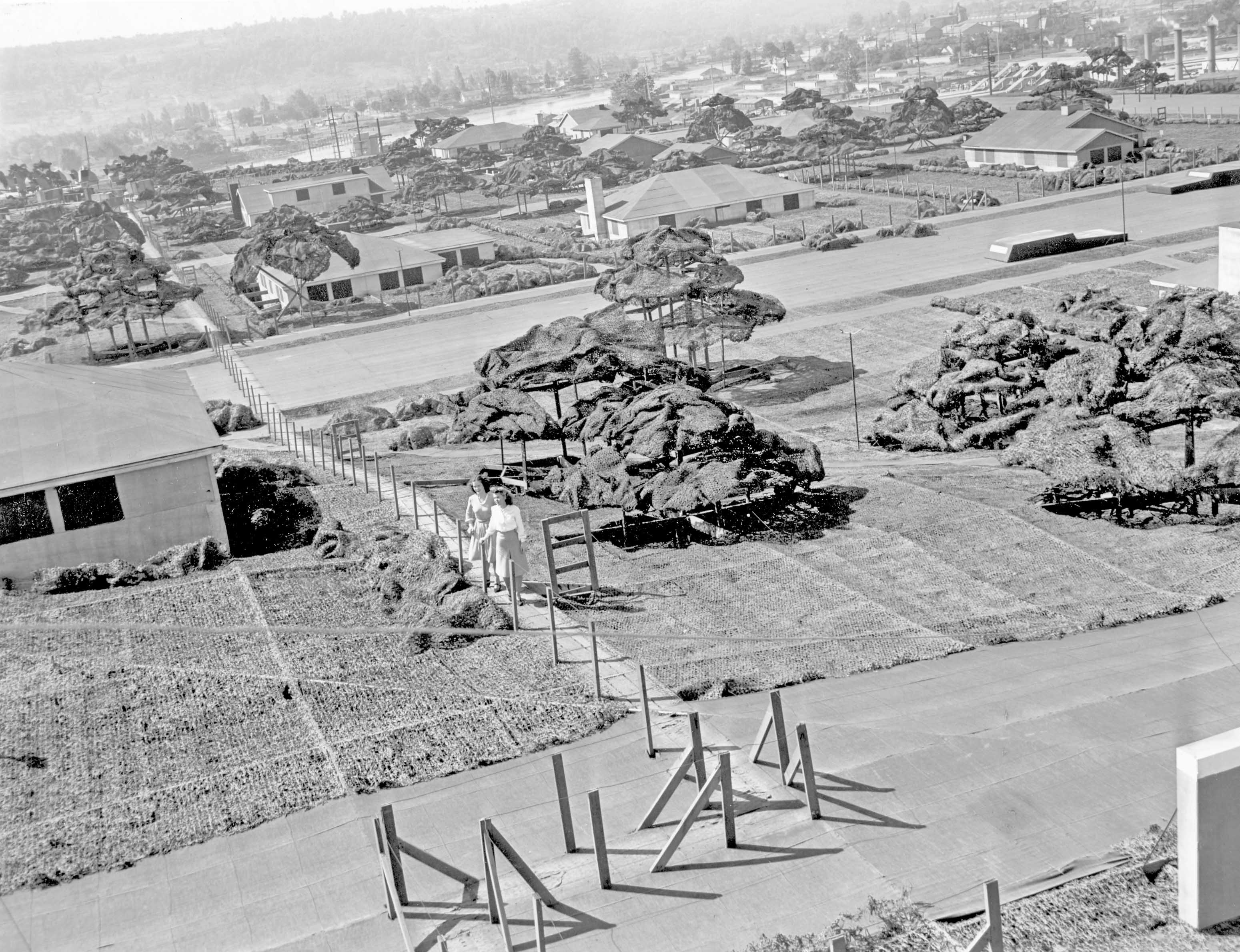
This act of concealing the Boeing Plant 2 evokes, if not exaggerates, the theoretical premise set forth by Le Corbusier in his book Aircraft, published only a few years earlier in 1935. For the first time in history, Corbusier writes, with the emergence and profusion of the aerial perspective made possible by flight and photography, architects had to be equally mindful of how the built environment would be experienced from the air as well as from the ground. Moreover, the aerial view would become a new, productive tool for the future reading, design, and representation of space. As Corbusier writes, “The eye now sees in substance what the mind formerly could only subjectively conceive. It is a new function added to our senses. It is a new standard of measurement. It is a new basis of sensation. Man will make use of it to conceive new aims. Cities will arise out of their ashes.”5
This was particularly true for Detlie and Boeing Plant 2, where the aerial perspective became the driving force behind the conception of camouflage. Detlie united all of the buildings of Boeing Plant 2 beneath a single, all-encompassing architectural gesture that, while too compressed for human use, would nonetheless appear inhabitable from an aerial vantage point. That is to say, Detlie gave Boeing Plant 2 what it previously lacked: a fifth façade.
With the roof and the aerial perspective in mind, consider also the significance of the small Dutch town of Middleburg, Netherlands, in the year 1608. It was here that, by chance, an optician named Hans Lippershey noticed that the weathervane of a nearby church appeared to be larger when viewed through a particular combination of convex and concave lenses. Scattered by the far-reaching hulls of the Dutch shipping industry, news of Hans’s discovery reached Padua, Italy, where our methods of recording observations would change forever when an Italian astronomer named Galileo Galilei placed similar lenses in a pair of nested tubes and pointed them at the night sky.6 With this, the telescope was born, and it instantly found use as a representational tool as Galileo replicated his observations of sunlight moving across the magnified surface of the moon through hand sketches. The same technique was improved two centuries later with Daguerre’s first attempts at astrophotography.7
The binding moment among these histories—that of Detlie’s Boeing Plant, Galileo’s telescope, and Corbusier’s Aircraft—occurred on March 7, 1947, when NASA scientist John T. Mengel placed a camera in the nose shell of a captured German V-2 rocket and shot it over one hundred miles above the earth’s surface, taking the world’s first photographs of the planet as viewed from space.8 Within a decade, words like Sputnik, Vanguard, Discoverer, and Apollo would become household terms as the Space Race rapidly evolved the methods by which we observe, record, and represent the planet we inhabit.
During this period, the expertise of photography began to merge with those of astronomy and the military. With the need to overcome the new and increasingly greater distances created between objects and their observers, photographers, scientists, and soldiers conspired to advance our capabilities of magnification and surveillance.9 Material evidence of these collaborations can be traced to the 1950s and ’60s, when the US Air Force and US National Reconnaissance Office joined with NASA to construct massive satellite calibration charts on concrete pads in the barren landscape of California’s Mojave Desert and Case Grande, Arizona, to practice photography from the vantage point of various air- and spacecraft. Formerly relegated to testing cameras and telescopes in the confines of the laboratory, the military liberated these charts into the laboratory of the built environment to further refine our ability to crop, zoom, focus on, and ultimately document the Earth from a cosmic perspective.10 In other words, beyond the perspective of the aircraft, in the second half of the twentieth century, our record of reality expanded when we turned Galileo’s telescope around and began to look back at ourselves.11
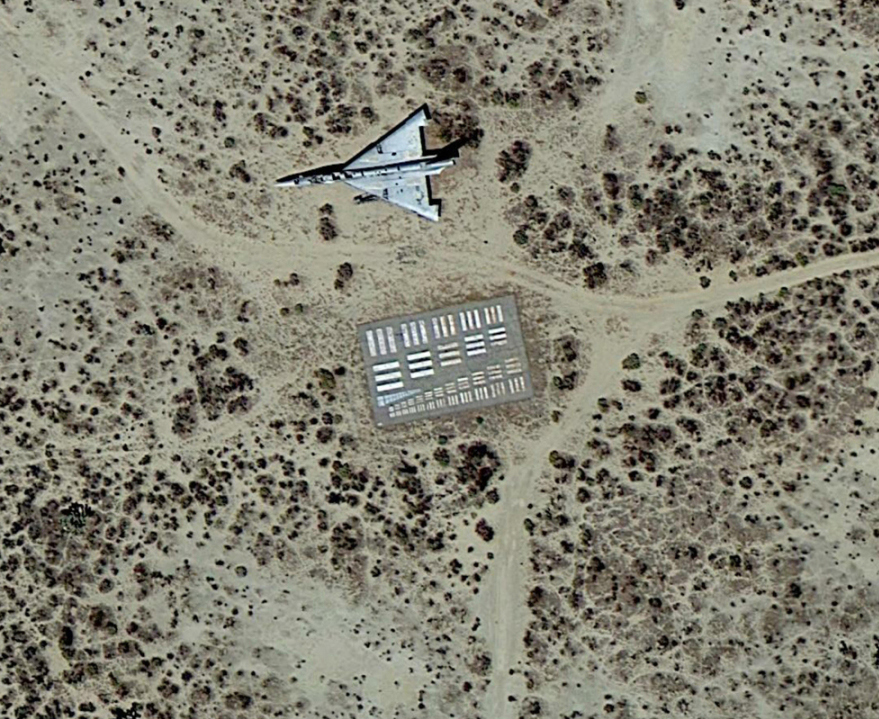

Boeing Plant 2 and these calibration targets are material evidence of the effects of the aerial perspective on the built environment during World War II. What is the impact of this perspective on the way we both perceive and conceive of space, form, and inhabitation today—over half a century later—with photographic technology that provides even greater clarity from far more distant vantage points?
One answer to this question surfaced in March 2015 with the nearly simultaneous dissemination of images of the work of Pritzker Prize–winning architect Frei Otto alongside the initial renderings of BIG and Heatherwick Studio’s first design for the new Googleplex in Mountain View, California. Otto’s resurgence in the media occurred just one day after he passed away, when he was posthumously awarded the Pritzker Prize on March 10, 2015. Just two weeks prior, Google distributed a press release regarding the first proposal for their new headquarters. The timing could not be ignored as the proposal for the Googleplex evoked the large, tensile roof structures for which Otto is celebrated.12 Certainly these structures are meant to be inhabited from below, but are they also meant to be experienced from above?
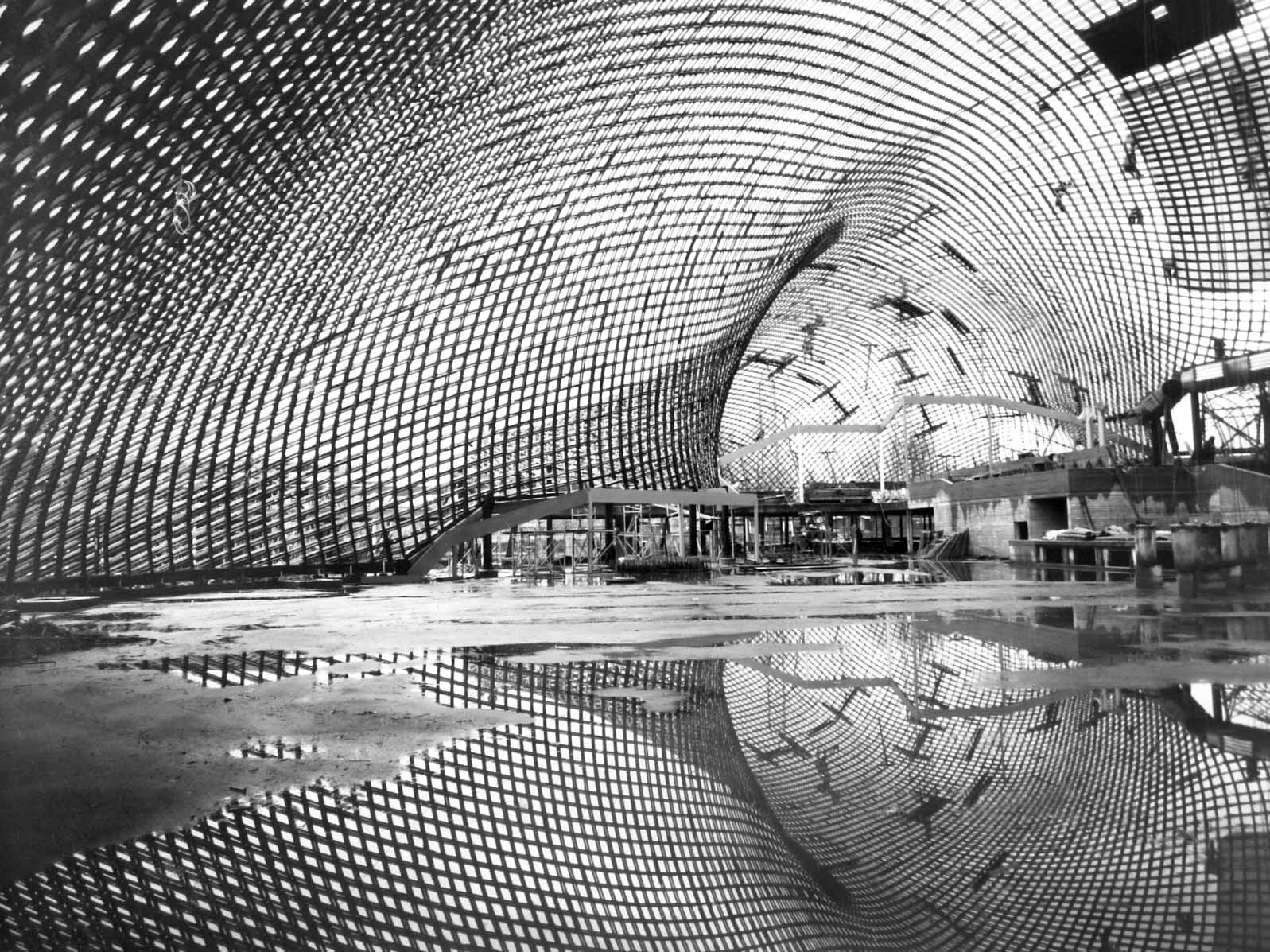

For Otto, this question can be addressed by looking at his 1984 drawing “What Is Nature?” in which he reveals his enthusiasm for flight with the sketch of an airplane suspended above a collection of his imaginative architectural explorations. Otto’s connection to the aircraft can be traced back to his childhood hobby of building model airplanes and gliders and continued into his teenage years, when he served as a pilot in the German air force during World War II. This period piqued his formal inquiry into notions of suspension and marked the beginnings of the special lightness with which his work would come to be known.13 In a tribute to Otto for his eightieth birthday, which was included in an exhibition of Otto’s work at the Technische Universität München, Norman Foster testified to the influence of the aircraft on Otto’s work: “Whereas in my youth I made models of classic fighter aircraft, Frei Otto spent his late teens as a pilot actually flying them in action.... It is perhaps his enduring love of flight that has guided his approach to architecture. His has always been an architectural vocabulary inspired by lightness.”14
For Otto, the influence of flight on his work was twofold: Space and form were inspired in equal measure by a rigorous understanding of aircraft structure and a concern for how the structure would be viewed from above. Contrasting with Otto’s structure-first approach is BIG and Heatherwick Studio’s proposal for the Googleplex, which aligns more closely with the form-by-aerial-view approach of Boeing Plant 2. Their initial proposal from 2015 featured a series of lightweight, rearrangeable structures stacked within the confines of a similarly all-encompassing and mostly transparent surface reminiscent of the iconic tensile canopy of Otto’s 1972 Munich Olympic Stadium. More recent renderings feature a similarly monolithic but now mostly opaque canopy covering two stories and nearly six hundred thousand square feet (the original proposal was nearly 3.5 million square feet) of program on its nineteen-acre site.15
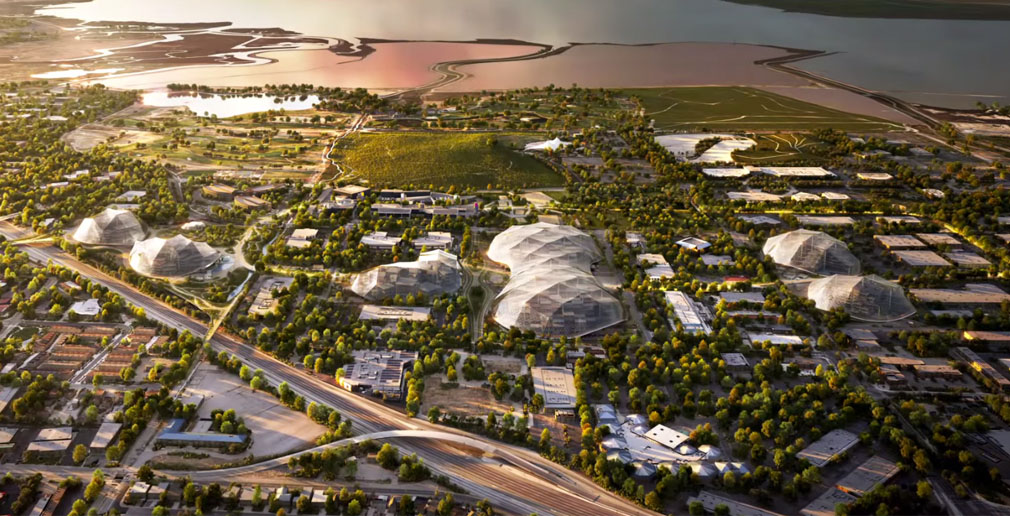

With either proposal, Google, BIG, and Heatherwick are unambiguous about their interest in how the Googleplex will be experienced from above. The promotional video for the initial scheme describes the architecture almost entirely through aerial perspective, including an opening flyover shot of the existing Google headquarters in Mountain View.16 The latest Googleplex proposal was also introduced to the public with a rendering from the vantage point of an oblique aerial view.17
In his proposed master plans for Paris, Chandigarh, Buenos Aires, and many other cities, Corbusier celebrated the bird’s-eye view for its ability to magnify the totality of a design’s impact by neutralizing the landscape around it.18 As demonstrated with the half-scale houses of the Boeing Plant 2 camouflage, when primacy is given to a view from a distance, what ultimately matters is the grand gesture, not the details. By doubling down on the presentation of their schemes from an aerial vantage point, Google, BIG, and Heatherwick, who are no strangers to the grandiose, confirm that the Googleplex will be a pill best swallowed whole.
But unlike Bjarke Ingels or Thomas Heatherwick, Le Corbusier and Otto lived in a time when flight was still a novel experience, and so one can understand their interest in the aerial view’s budding impact on the architectural discipline. In 2017, is the liberal use of aerial perspective in the Googleplex imagery merely the practice of contemporary conventions in architectural representation? Or, unlike Boeing Plant 2, Corbusier, and Otto’s work, is the Googleplex’s canopy created with the intent that it be experienced through something more robust than satellites or aircrafts alone?
With a mission “to organize the world’s information and make it universally accessible and useful,” it is important to underscore Google’s role not only as a pioneering technology company but one whose focus is on total dissemination of knowledge.19 More than its mission, Google is also very careful in how the company crafts its own cultural and public perception. Playful graphics and office interiors and a company motto of “Don’t be evil” ultimately cultivate an image that attempts to soften the sprawling power the company actually wields. And with over ten billion images indexed in their search engines receiving more than one billion hits per day, Google is a company that understands the power of imagery.20 The extensive scale and sprawl of the Googleplex, coupled with the corporation’s ambition, implies that the desired aerial perspective would be through a technology more advanced than merely aircrafts, from a position less rigid than the fixed vantage point of an orbiting satellite, for public access that transcends conventional publication and visual media. In other words, is it possible that we are meant to perceive the Googleplex from a perspective only possible through the lens of their own product—Google Earth?

Unlike Boeing Plant 2, which sought to impersonate its immediate context, the Googleplex canopy seeks to be a standout presence, equally noticeable when viewed as a digital image or a physical structure. For anyone who would orbit the facility in Google Earth, or simply photograph the building in person, the uniform canopy would maintain itself as a recognizable icon regardless of one’s angle of observation. It is as much a point in physical space as it is a pixel in digital space. This is already apparent in BIG and Heatherwick’s most recent design review with the city of Mountain View, where each page of their drawing package features a black-and-white logo of the Googleplex drawn as it will appear when viewed from directly above.21 Thus, for a ubiquitous digital company seeking the architectural translation of its identity, the canopy of the Googleplex becomes the uniform, fixed, and readily identifiable object that mediates between Google’s position in both the physical and digital world.
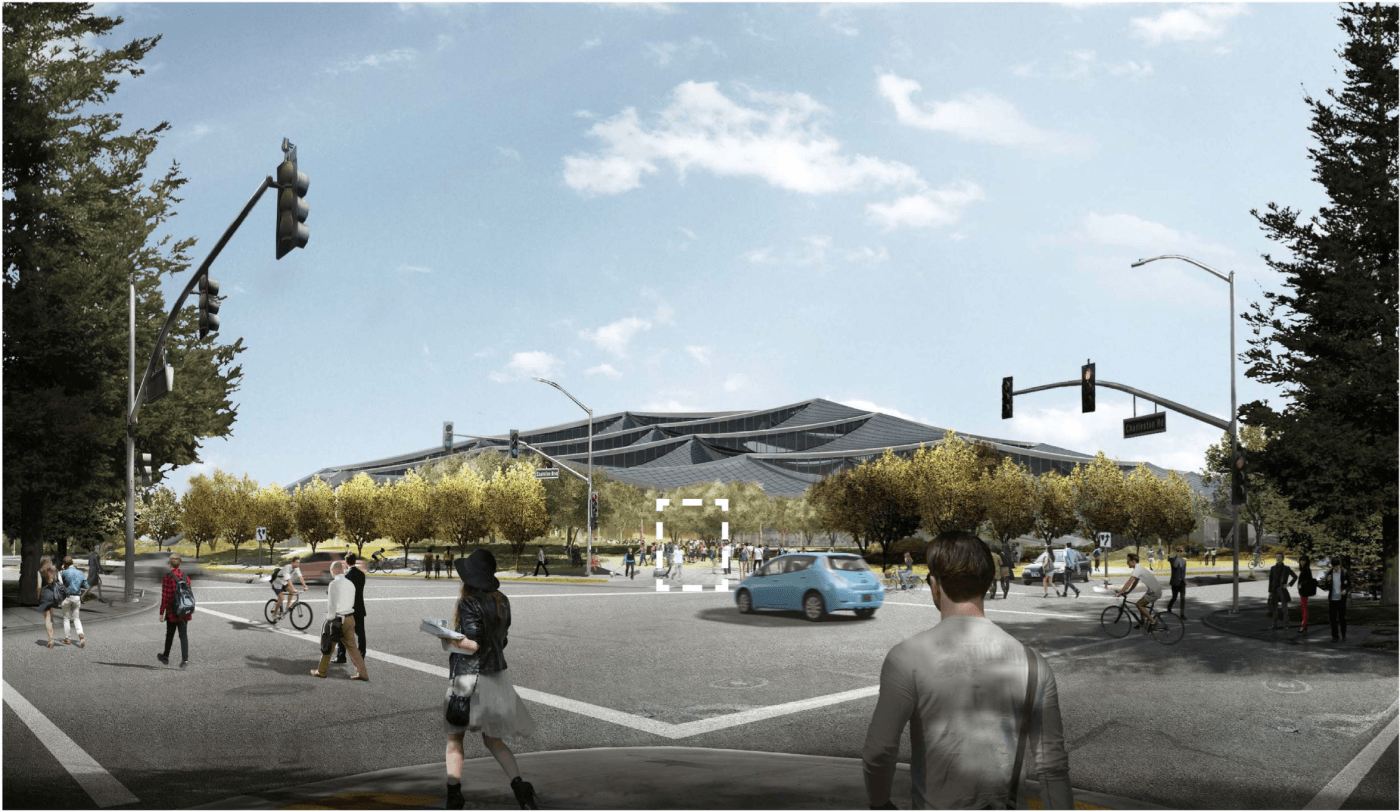
This means that, as the creator of Google Earth and the Googleplex, Google governs both the perspective and the content of that perspective, and they are free to continually alter one to suit the other for public consumption. As an example, take the telescopic photography of celestial objects. They appear at once the stunning result of a single photograph but, in fact, are the result of an aggregation of many black-and-white images to which layers of color are later added in Photoshop.22 It is not unlike the unavoidable subjectivity of Galileo’s hand as he sketched his perception of the moon or, say, the way an architect might intentionally alter a photograph of a building before publicly releasing the image or design a space with a particular perspective in mind.
Consider as well the story of the nineteenth-century astronomer Percival Lowell, whose life’s work is credited with leading to the eventual discovery of Pluto only a few years after his death. Lesser known is Lowell’s discovery of the intricate, spoke-like canal systems on the surfaces of the planets Mars and Venus, observations that he recorded in numerous hand drawings and papers presented to the Royal Astronomical Society and the American Academy of Arts and Sciences. Such a discovery would have been groundbreaking for the field of astronomy, except that no such canal systems exist on the surfaces of either Mars or Venus.
While there was some skepticism among Lowell’s contemporaries, it was not proven until 2003, a full century later, that the canals he observed were not on the surface of either planet but were merely a reflection of the blood vessels in his own retina due to defective settings of his telescope lens. But for a period of time, there existed a particular set of images of record with which his colleagues and the general public viewed these two planets quite literally through Lowell’s eyes.23

Right: Percival Lowell’s sketch of the “canals” of Venus. Originally published in William Sheehan and Thomas Dobbins’ “The Spokes of Venus: An Illusion Explained."
The parable of Lowell’s canals being that, in the case of the Googleplex, we as observers and users must realize that if the building’s canopy is its fifth façade, then Google Earth is its sixth—an accumulation of perspectives that represent and publicize the company’s identity but that also, as was the case with Boeing Plant 2, obscure the distance between the perception and reality of space. Observation through Google Earth is observation through Google’s eyes, and the Googleplex is the embodiment of this concept. Google, as well as the third-party companies who own the satellites that provide their aerial photography, have conceded that they alter Google Earth imagery to suit particular circumstances, but the Googleplex will be the first example of the company altering the built environment to suit Google Earth.24 Building on the theoretical premise set forth by Corbusier more than eighty years ago, Google, BIG, and Heatherwick are using the aerial perspective to transform the way we conceive, experience, and access architecture. But if Google Earth is our new record of reality, it is only reality insofar as Google wishes for us to perceive it.
-
Le Corbusier, Aircraft (London: Trefoil 1987), 102. ↩
-
Donna Gordon Blankinship, “Architect Detlie Helped ‘Hide’ Boeing Plant,” the Seattle Times, December 5, 2005, link. ↩
-
See photographer Tom Philo’s image of the Boeing Plant 2 camouflage, link. ↩
-
Bill Yenne, The American Aircraft Factory in World War II (Grand Rapids, Michigan: Zenith, 2006), 114. ↩
-
Le Corbusier, Aircraft, 96. ↩
-
Henry C. King, The History of the Telescope (Mineola, NY: Dover Publications, 2003), 30–36. ↩
-
King, The History of the Telescope, 224. ↩
-
NASA Content Administer, “First Pictures of Earth from 100 Miles in Space, 1947,” NASA, March 6, 2009, link. ↩
-
In The Age of the World Target, Rey Chow notes how the United States began to prepare military operations by contracting filmmakers to capture aerial photographs of potential target sites under the guise that they were scouting filming locations. Rey Chow, Age of the World Target (Durham, NC: Duke University Press, 2009), 30. ↩
-
Center for Land Use Interpretation, “Landscape Photographs of Photographic Landscape Targets,” Boom California, September 3, 2015, link. ↩
-
In The Human Condition, Hannah Arendt argues that for millennia, dating back to the third century BC when Archimedes’ hypothesized that the Earth is a sphere, humankind has had the ability to imagine and represent our planet from a cosmic perspective (“...the great boldness of Copernicus’ imagination, which lifted him from the Earth and enabled him to look down upon her as though he actually were an inhabitant of the sun,” writes Arendt). It was not until the launch of Mengel’s rocket in 1947 and Sputnik in 1957 that technology finally superseded human imagination with the first recorded reality of Earth as it is seen from space. As Arendt notes, rather than being publicly celebrated, this new reality was met with trepidation and fear as satellites were first and foremost an advancement in the methods of military surveillance, not a triumph of scientific achievement. Hannah Arendt, The Human Condition (Chicago, IL: University of Chicago Press, 1958), 1–4, 258–259. Lisa Parks points out that satellites were also more than just producers of images. For the first time in history, satellites made it possible to publicize an image simultaneously at different locations across the globe. The earliest example of this occurred with the live global broadcasting of the 1964 Tokyo Olympics via satellite television. Lisa Parks, Cultures in Orbit: Satellites and the Televisual (Durham, NC: Duke University Press, 2005), 2–5. ↩
-
Christopher Hawthorne, “Architect Frei Otto Awarded Pritzker Prize a Day After His Death,” the Los Angeles Times, March 10, 2015, link. ↩
-
Fred A. Bernstein, “Frei Otto, Architect, Dies at 89; the Soap Bubble Was an Inspiration,” the New York Times, March 10, 2015, link. ↩
-
Norman Foster, “Eightieth Birthday Appreciation,” Frei Otto: Leicht Bauen, Natürlich Gestalten, link. ↩
-
Square footages taken from the drawing review package submitted to the city of Mountain View, California, on January 23, 2017. ↩
-
Google’s Proposal for North Bayshore, YouTube, February 27, 2015, link. ↩
-
Abner Li, “Google Shares Latest Plans and Renders of Impressive New Mountain View Campus,” 9to5 Google, February 17, 2017, link. ↩
-
James C. Scott, Seeing Like a State: How Certain Schemes to Improve the Human Condition Have Failed (New Haven, Connecticut: Yale University Press, 2008), 103–106. ↩
-
“Our Story: From the Garage to the Googleplex,” Google, link. ↩
-
Nate Smith, “Ooh! Ahh! Google Presents a Nicer Way to Surf the Visual Web,” Google Blog, July 20, 2010, link. Other sources estimate the number of indexed images to have approached one trillion today. ↩
-
See BIG and Heatherwick Studio’s formal drawing review for Google Charleston East with the city of Mountain View, California, January 23, 2017, link. ↩
-
In her book Close Up at a Distance, Laura Kurgan notes that Google Earth is created in a similar patchwork manner. Though it appears as a single seamless image, Google Earth is a mosaic of archival satellite imagery “of varying origins, sources, motivations, and resolutions” taken at differing times on different dates. The result is a composite of various histories presented as if being the still shot of the world at a single point in time. Laura Kurgan, Close Up at a Distance Mapping, Technology, and Politics (Cambridge, MA: MIT Press, 2003), 20–21. See also Clara Moskowitz, “Truth Behind the Photos: What the Hubble Space Telescope Really Sees,” Space, March 18, 2010, link; and the official YouTube channel for the Hubble Telescope describing the Photoshop process, link. ↩
-
William Sheehan and Thomas Dobbins, “The Spokes of Venus: An Illusion Explained,” Journal for the History of Astronomy, vol. 34, no. 114 (2003), 53–63. ↩
-
Nina Rastogi, “Google’s Blind Spots,” Slate, December 01, 2008, link. ↩
Adam Longenbach is a researcher and writer based in New York City. His drawings and writing have been published through Frame Publishers, Blank Space Publishing, Lantern Journal, the Pennsylvania State University Press, and others.

